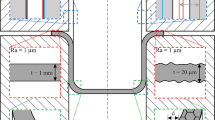Abstract
Center cracks frequently occur during extrusion cutting. These cracks are often caused by uneven material flow velocities, which may also increase the material’s hardness and cause surface fractures and unevenness. In this study, simulations and experiments were performed to determine whether a novel grooved punch can stabilize the material flow velocity of a billet during extrusion cutting. The relationship between the punch and die outlet geometry was also investigated. If the punch dimensions are smaller than those of the die outlet, the product shrinks and fractures. Larger punches can prevent these defects but increase the material flow velocity, causing sinking at the center. Finite element analysis and experiments conducted with grooved punches revealed that both shallow and deep grooves can improve the control of material flow and delay acceleration. Punches with greater volume both increase and stabilize the material’s acceleration. The dimensions of the grooved punch must be similar to those of the die outlet to ensure optimal material flow.













Similar content being viewed by others
References
Huang YM, Chen JM (2013) Surface permeation and die design during rod extrusion process. Int J Adv Manuf Technol 69:397–403. https://doi.org/10.1007/s00170-013-5036-4
Wang JP (2015) A novel fine-blanking approach. Int J Adv Manuf Technol 78:1015–1019. https://doi.org/10.1007/s00170-014-6701-y
Wang JP, Huang GM, Lee H-D, Chen C-C, Chen T-T, Chen C-L (2013) Optimization of Hydro-Blanking. Steel Res Int 84:777–783
Huang GM, Wang JP, Chen TT, Chen CL, Xu MH (2015) Optimal design for the fluid cavity shape in hydro mechanical fine blanking. Int J Adv Manuf Technol 78:153–161. https://doi.org/10.1007/s00170-014-6591-z
Chen CL, Wang JP, Huang GM, Hsu MH, Chen TT (2017) High-precision rapid prototyping technology for manufacturing linear guides. Int J Adv Manuf Technol 92:3137–3142. https://doi.org/10.1007/s00170-017-0378-y
Majeed A, Zhang YF, Ren S, Lv JX, Peng T, Waqar S, Yin E (2021) A big data-driven framework for sustainable and smart additive manufacturing. Robot Comput Integr Manuf 67:102026. https://doi.org/10.1016/j.rcim.2020.102026
Foivos P, João S, João PM, Dimitris K (2021) Zero-defect manufacturing the approach for higher manufacturing sustainability in the era of industry 4.0: a position paper. Int J Prod Res 60(1):73–91 https://doi.org/10.1080/00207543.2021.1987551
Han Q, Zhang J (2020) Fluidity of Alloys Under High-Pressure Die Casting Conditions: Flow-Choking Mechanisms. Metall Mater Trans B 51:1795–1804. https://doi.org/10.1007/s11663-020-01858-0
Kallas MK (2019) US Patent Application Number 15874348. https://patentscope.wipo.int/search/en/detail.jsf?docId=US248873852&tab=PCTDESCRIPTION. Accessed 20 June 2022
Wang JP, Huang GM (2016) Fine extrusion device approach. Int J Adv Manuf Technol 86:1733–1737. https://doi.org/10.1007/s00170-015-8277-6
Giardini C, Ceretti E, Maccarini G (1995) Formability in extrusion forging" the influence of die geometry and friction conditions. J Mater Process Technol 54:302–308. https://doi.org/10.1016/0924-0136(94)01780-8
Wu CY, Hsu YC (2002) The influence of die shape on the flow deformation of extrusion forging. J Mater Process Technol 124:67–76. https://doi.org/10.1016/S0924-0136(02)00030-4
Sahu RK, Das R, Routara BC (2020) Studies on die designs in multi-hole extrusion process. Mater Today Proc 26:3043–3047. https://doi.org/10.1016/j.matpr.2020.02.632
Kim BM (2003) New processes to prevent a flow defect in the combined forward–backward cold extrusion of a piston-pin. J Mater Process Technol 139:422–427. https://doi.org/10.1016/S0924-0136(03)00515-6
Hu W, Hashmi MSJ, Liu P (1994) Study of material flow in extrusion forging of rectangular billets. J Mater Process Technol 43:51–59
Zheng PF, Chan LC, Lee TC (2006) Finite-element analysis of a combined fine-blanking and extrusion process. Int J Numer Methods Eng 66:404–430. https://doi.org/10.1002/nme.1556
Chen ZH, Tang CY, Chan LC, Lee TC (1999) Simulation of the sheet metal extrusion process by the enhanced assumed strain finite element method. J Mater Process Technol 91:250–256. https://doi.org/10.1016/S0924-0136(98)00419-1
Li F, Chu GN, Liu EL, Wu RZ, Zhang XL (2011) Investigation of metal extrusion forming through steadily rotating container. J Mater Eng Sci 225:2927–2937. https://doi.org/10.1177/0954406211411405
Acknowledgements
The authors would like to express our gratitude to the Ministry of Science and Technology of Taiwan for their financial assistance extended to a part of this study, which makes the experimental work possible. This research under Contract No. MOST 109-2221-E-019-003-MY2. They are also grateful to SFTC for help in running the DEFORM-3D software.
Author information
Authors and Affiliations
Contributions
All authors certify that have participated sufficiently in the work to take public responsibility for content. First concept and draft of the manuscript was written or revision by Kuo-Ming Huang. Ming-Huang Hsu and Joseph Ramanuel on material preparation, data collection and analysis were performed the analysis with constructive discussions. Chuan-Hsaing Chang and Jiang-Ming Wey were performed the experiment design and testing. Furthermore, each author certifies that this technology or similar manufacturing technology has not been and will not be submitted to or published in any other publication before its appearance in the “The International Journal of Advanced Manufacturing Technology.”
Corresponding author
Ethics declarations
Conflict of interest
The authors declare no competing interests.
Additional information
Publisher's note
Springer Nature remains neutral with regard to jurisdictional claims in published maps and institutional affiliations.
Rights and permissions
Springer Nature or its licensor (e.g. a society or other partner) holds exclusive rights to this article under a publishing agreement with the author(s) or other rightsholder(s); author self-archiving of the accepted manuscript version of this article is solely governed by the terms of such publishing agreement and applicable law.
About this article
Cite this article
Huang, KM., Hsu, MH., Ramanuel, J. et al. Improvement of product quality using negative clearance grooved punch. Int J Adv Manuf Technol 125, 479–492 (2023). https://doi.org/10.1007/s00170-022-10383-0
Received:
Accepted:
Published:
Issue Date:
DOI: https://doi.org/10.1007/s00170-022-10383-0




